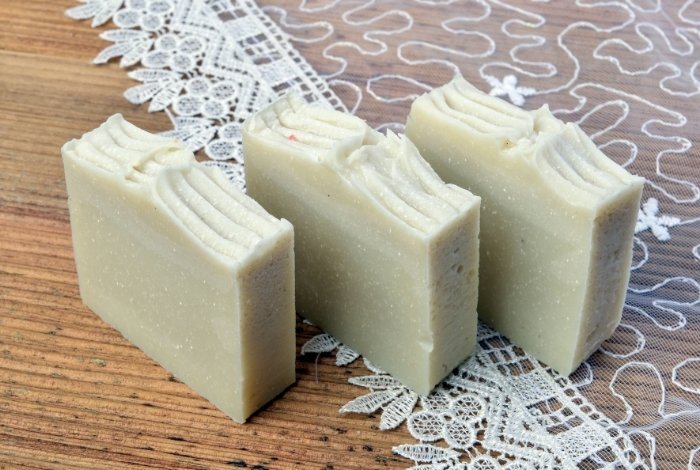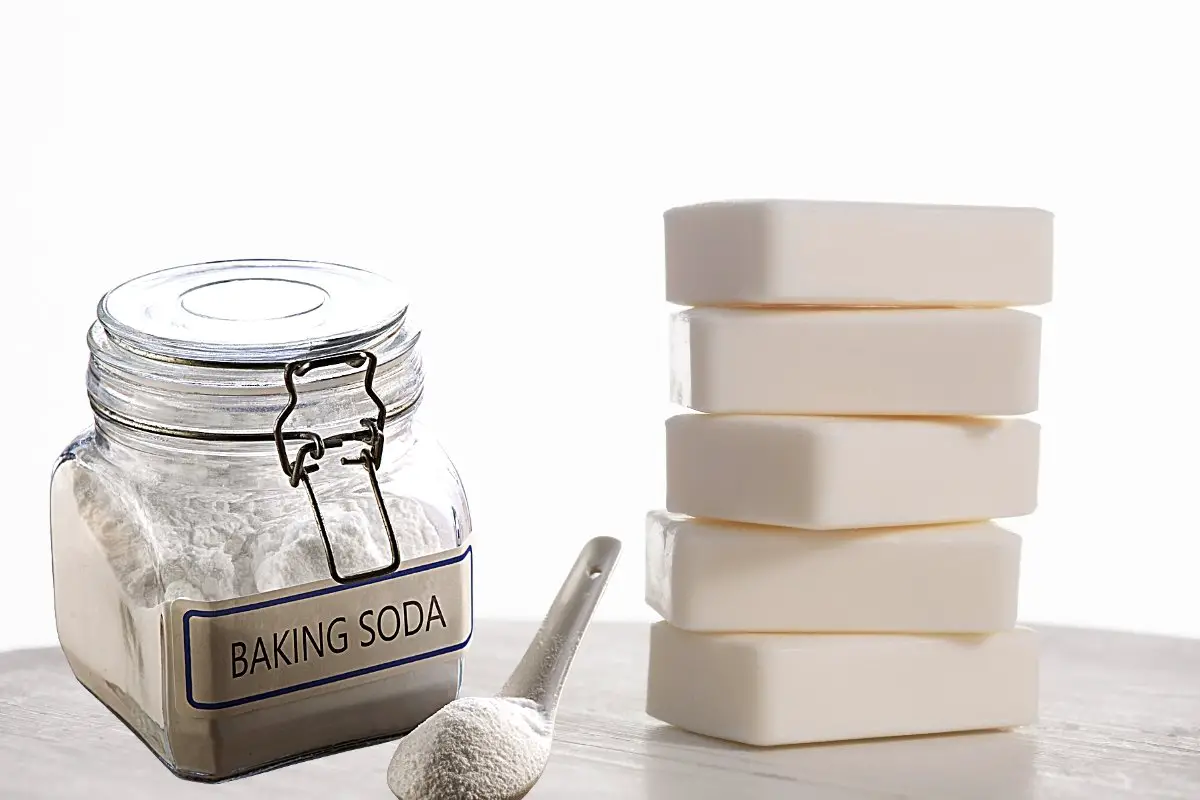Last Updated on October 12, 2024
When it comes to natural ways to make household soap for cleaning and washing, there are many ingredients available to use. And one of the chief ingredients used by many DIY soap makers is lye. But is there another alternative for those looking to avoid the sticky-icky that comes with handling lye? How about making soap with baking soda instead of lye? This is another way to go about making DIY homemade cleaning agents without too much stress.
Table of Contents
Why Avoid Lye?
There are many reasons why most soap makers add lye to their products. For one, the natural fat contained in the lard is known to help moisturize the skin. But it is for this same reason that many people look to avoid it in their cosmetics. Too much fat could spell doom for the skin. And if you suffer from skin sensitivity, you have every right to look for safer alternatives.
Although most cosmetic products containing the compound have been diluted to reverse the harsh effects on the skin, making soap with lye can damage the skin. And if you do choose to use it at home, you want to make sure to follow all safety precautions with soap manufacturers.
Baking Soda In Soap manufacturing
The fine white powder of sodium bicarbonate (baking soda) is highly effective in skincare and beauty. And as such is widely used in making organic homemade soap and washing products. Including baking soda in the mix helps with the saponification process resulting in a hard bar you can work with. This also helps to influence the lather, so you don’t get a soft concoction that doesn’t do much washing.
When it comes to using making soap with baking soda instead of lye, there are safety procedures you want to follow. But the good part is you get to avoid most of the harsh effects on the skin, unlike when you use lye.
Why Consider Baking Soda In Your Soap
There are many ways baking soda could be effective in soap manufacture, and if you wonder just how, below are reasons to include them in your laundry products.
Treat Yeast Infection
Whether you use them in a baking soda bath by including them in your bath water or mixing it in your soap ingredients, you indeed will find them helpful for the skin. Want relief from all the swelling and itching from a yeast infection? You can trust baking soda to help kill the candida cells responsible for the spread.

Skin Infections
In addition to yeast infections, you will also find baking soda to help deal with many other skin challenges. You could choose to add it to your bath water or soap making to help deal with psoriasis, eczema, fungal, and nail infections. It will also help treat nappy rash in babies and as a drawing salve to get out splinters, so yes, it has many benefits for the skin.
Making Soap With Baking Soda Instead Of Lye
Want to use baking soda in your soap instead of lye, you would have to switch out lye for something milder. And this case, we will be making use of essential oils instead of lye. However, you will have to wait a while for it to harden. If you don’t mind the time, you can be sure to get the quality you desire. Below is the simple procedure for making homemade soap with baking soda.
Ingredients
- A bowl of baking soda
- 5-10 drops of essential oil (eucalyptus, lavender, or rose)
- Container for keeping your soap
- Water
- Spoon for stirring
Bath Bomb Mold Set with Soap Colorant, Shrink Wrap Bags – Skin Safe Food Grade Soap
Procedure
- The first step is to pour the baking soda into the container. You want to allow a little room for stirring, so halfway full should be enough.
- Slowly add in the water until you notice a paste.
- Add in a few drops of your essential oil of choice and stir. It is best to go for mild options that help improve skin therapy. I find eucalyptus, lavender, cinnamon, and Frankincense are some of the best options for the skin. You could also use any suitable essential oil for the skin in your soap-making. You want to ensure it does not leave you with any irritation.
- Continue stirring and adding more water and baking soda until you achieve a solid form in your container. That’s it; your organic soap is ready for use.
Does Soap Contain Baking Soda?
The use of baking soda in soap making is quite a conflicting topic and there is no straightforward answer because some swear by its effectiveness while others simply cannot think of it. However, depending on the manufacturer’s preference, you can find soaps containing baking soda in stores around the world. Moreover, baking soda is an excellent alternative to lye, an ingredient that can both nourish and harm your skin. It can be considered a kind of double-edged sword that needs to be handled with care.
If your soap contains baking soda, these are some of the benefits you can expect after the first use: softer skin thanks to exfoliation, reduction of fungal infections, and relief of discomfort caused by sunburn.
Is Baking Soda a Soap?
No, baking soda is not soap! Baking soda, also known as sodium bicarbonate is the most common possible chemical compound that can be found in nature in crystalline form, but is mostly ground into a fine powder, and is activated by a liquid and an acid to help with leavening, or rising baked goods.
Furthermore, we must emphasize that although it is not soap per se, it is very possible to make an effective cold-process soap using baking soda. What most of you probably won’t like is the fact that it doesn’t lather like other products of this type that we are used to.
Does Baking Soda Neutralize Soap?
No, baking soda won’t neutralize the soap, however, vinegar and salt certainly can. Namely, if you ever decide to experiment when cleaning the house, we advise you not to experiment with mixing liquid soap with vinegar because the beneficial properties of both are neutralized when mixed.
Furthermore, if you want to neutralize soap suds, baking soda can be helpful. All you need to do is make a DIY paste from a few kitchen staples, i.e. one cup baking soda and one-fourth cup white distilled vinegar, and if you want, you can even add a few drops of liquid soap to it. Simply mix the ingredients, spread the paste on the dirty area, and scrub with a non-abrasive sponge or microfiber cloth. Rinse off after a few minutes and that’s it.
Is Baking Soda The Same as Sodium Hydroxide?
Although people often confuse them, no, baking soda and sodium hydroxide are not the same things, hence this question. Sodium hydroxide comes from sodium carbonate, professionally known as ‘caustic soda’, while baking soda, on the other hand, is another name for sodium bicarbonate.
So, these are two fairly alkaline substances, which, although both have a much higher ph than neutral, are quite characteristic and distinctive. In short, they have different chemical names/formulas and different properties. However, are you ready to discover the biggest difference between them? Unlike caustic, baking soda is non-corrosive and non-toxic, and can be consumed without poisoning or killing you.
*Click here to learn more.
Will baking soda neutralize sodium hydroxide?
Are you in the mood for some chemistry? Well, that’s great! Don’t worry, we won’t suffocate you with boring formulas, we will just briefly explain what it is all about. Baking soda has an alkaline pH, which means it can neutralize acids like sodium hydroxide.
Is sodium hydroxide present in baking soda?
This topic literally cannot go without a chemistry lesson, but we will try to simplify it as much as possible so as not to create additional confusion. Regarding the presence of sodium hydroxide in baking soda, feel free to take it this way: baking soda has a hydrogen atom and in addition, contains one sodium atom.
How To Use Safely
All you need is to scoop it out of the container and apply it to the body. Scrub hard with the hands or a mild sponge and rinse after; this should help exfoliate the skin keeping it dirt-free.

Barbara is an environmental activist and sustainability advocate who loves living green and sustainable. She firmly believes in reducing her carbon footprint and has been making great strides towards achieving this goal. Barbara is a vegan and avid recycler and has been actively involved in community gardens and other green initiatives. She is passionate about spreading awareness about the importance of living in a sustainable and eco-friendly manner. Barbara is always looking for ways to make a difference in her community and beyond. She is a huge advocate for preserving nature and the planet for future generations.


